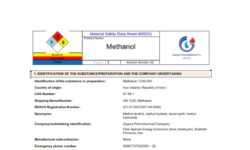Understanding Chemical Data in Industry
In today’s world, the management of chemicals is critical for ensuring safety and compliance in various industries, from manufacturing to pharmaceuticals. A comprehensive understanding of chemical data is essential for businesses, regulators, and consumers alike. This blog will delve into three key components of chemical safety and management: Chemical Data Reporting, Chemical and Engineering Data, and the Chemical Safety Data Sheet.
What is Chemical Data Reporting?
Chemical Data Reporting (CDR) refers to the process mandated by regulatory agencies, such as the Environmental Protection Agency (EPA) in the United States, requiring manufacturers and importers to submit detailed information about the chemicals they produce or import. This initiative is designed to gather essential data regarding the production, use, and potential environmental impact of chemicals.
CDR typically includes various types of information:
- Production Volume: Companies must report how much of each chemical they produce or import. This helps regulators understand the prevalence of specific chemicals in the market.
- Usage Information: Knowing how chemicals are used in different applications helps assess potential exposure risks to workers and consumers.
- Byproducts and Waste: Reporting on byproducts generated during production processes is vital for environmental safety.
Through Chemical Data Reporting, companies not only comply with legal requirements but also contribute to a broader understanding of chemical safety, ultimately promoting public health and environmental protection.
The Importance of Chemical and Engineering Data
Chemical and Engineering Data is vital for ensuring the safe and efficient handling of chemicals within various industrial processes. This data encompasses a wide range of information critical for engineers and safety professionals, including:
- Material Properties: Understanding the physical and chemical properties of materials is crucial for safe handling and processing. This includes information on melting points, boiling points, and solubility.
- Process Optimization: Access to detailed chemical and engineering data allows companies to optimize their processes, increasing efficiency while reducing waste and potential hazards.
- Safety Evaluations: Comprehensive data enables thorough safety assessments, helping to identify hazards and establish safe handling procedures.
By utilizing Chemical and Engineering Data, organizations can enhance operational safety, improve process efficiency, and reduce costs associated with accidents and regulatory fines.
What is a Chemical Safety Data Sheet?
The Chemical Safety Data Sheet (CSDS) is an essential document that provides detailed information about a specific chemical substance. It serves as a crucial resource for anyone working with or exposed to chemicals, including employees, safety personnel, and emergency responders. Key elements of a CSDS include:
- Identification of the Substance: This section lists the chemical’s name, synonyms, and recommended uses, providing a clear understanding of what the chemical is and its intended applications.
- Hazard Identification: It outlines the potential hazards associated with the chemical, such as toxicity, flammability, and environmental impact, allowing users to understand the risks involved.
- Safe Handling and Storage Instructions: This section provides guidelines on how to properly store and handle the chemical to minimize risks and ensure safety.
- Emergency Response Information: CSDS includes procedures for dealing with spills, exposures, and other emergencies, equipping users with the knowledge needed to respond effectively.
The Chemical Safety Data Sheet is a vital tool in promoting a culture of safety and compliance, ensuring that everyone who interacts with chemicals understands their risks and how to manage them appropriately.
In summary, the significance of Chemical Data Reporting, Chemical and Engineering Data, and the Chemical Safety Data Sheet cannot be overstated. These components play a crucial role in ensuring the safe management of chemicals across various industries. By adhering to these practices, companies can protect their employees, customers, and the environment while maintaining compliance with regulatory requirements. As the chemical landscape continues to evolve, staying informed about these key aspects of chemical safety will be paramount for all stakeholders involved.


